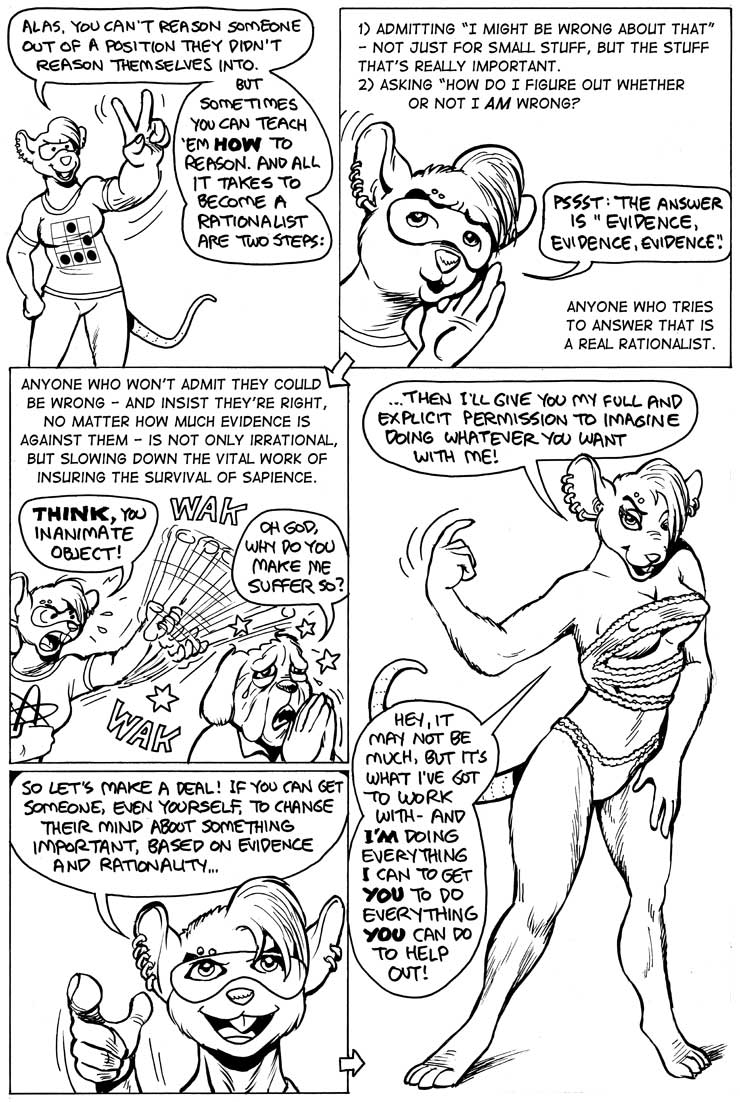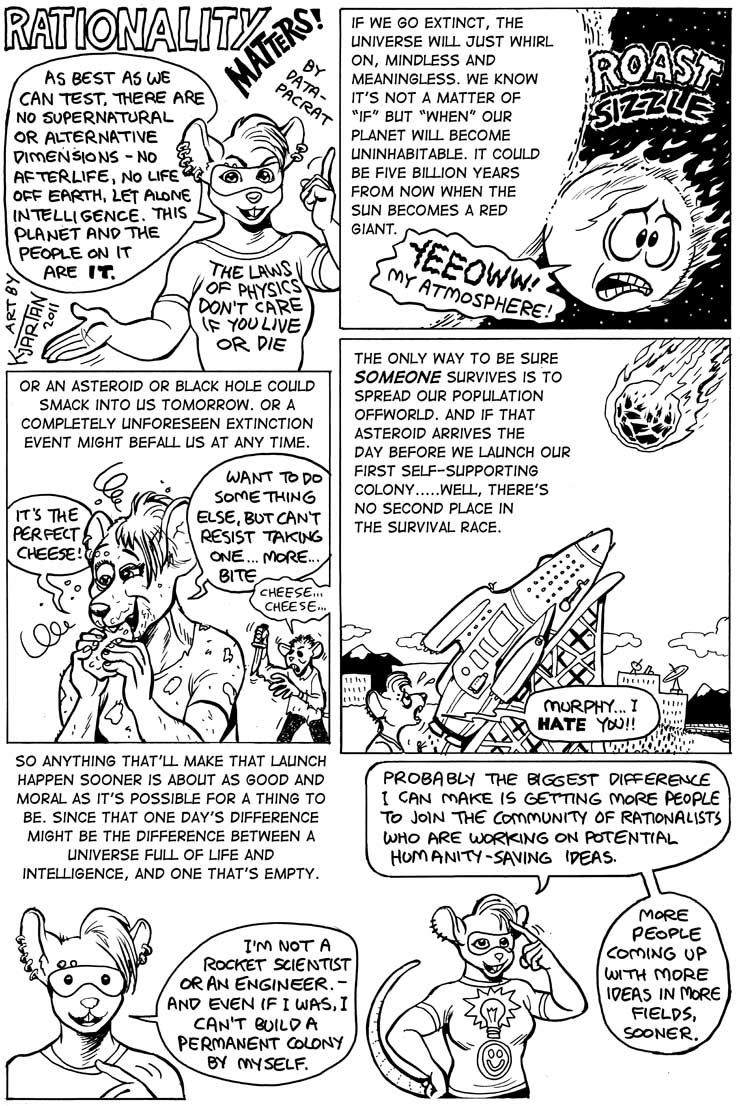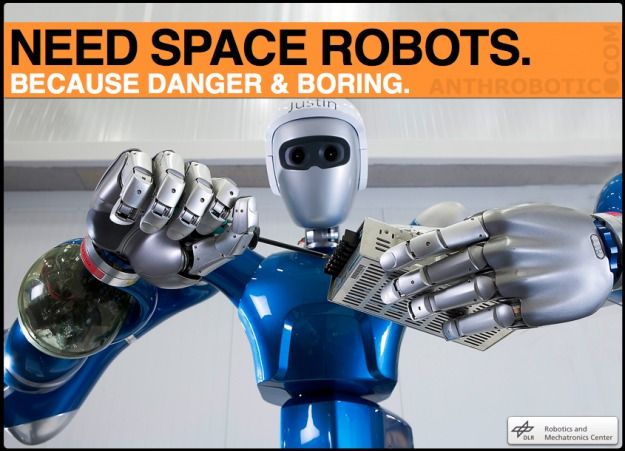


I had a great time at APS 2013 held April 13 — 16, 2013. I presented my paper “Empirical Evidence Suggest A Different Gravitational Theory” in track T10, Tuesday afternoon. A copy of the slides is available at this link.
http://www.iseti.us/WhitePapers/APS2013/Solomon-APS-April(2013-04-15).pdf
Have fun.
——————————————
Benjamin T Solomon is the author of the 12-year study An Introduction to Gravity Modification

A Point too Far to Astronaut
It’s cold out there beyond the blue. Full of radiation. Low on breathable air. Vacuous.
Machines and organic creatures, keeping them functioning and/or alive — it’s hard.
Space to-do lists are full of dangerous, fantastically boring, and super-precise stuff.
We technological mammals assess thusly:
“Robots. Robots should be doing this.”
Enter Team Space Torso
As covered by IEEE a few days ago, the DLR (das German Aerospace Center) released a new video detailing the ins & outs of their tele-operational haptic feedback-capable Justin space robot. It’s a smooth system, and eventually ground-based or orbiting operators will just strap on what look like two extra arms, maybe some VR goggles, and go to work. Justin’s target missions are the risky, tedious, and very precise tasks best undertaken by something human-shaped, but preferably remote-controlled. He’s not a new robot, but Justin’s skillset is growing (video is down at the bottom there).
Now, Meet the Rest of the Gang:
NASA’s Robonaut2 (full coverage), the first and only humanoid robot in space, has of late been focusing on the ferociously mundane tasks of button pushing and knob turning, but hey, WHO’S IN SPACE, HUH? Then you’ve got Russia’s elusive SAR-400, which probably exists, but seems to hide behind… an iron curtain? Rounding out the team is another German, AILA. The nobody-knows-why-it’s-feminized AILA is another DLR-funded project from a university robotics and A.I. lab with a 53-syllable name that takes too long to type but there’s a link down below.
Why Humanoid Torso-Bots?
Robotic tools have been up in space for decades, but they’ve basically been iterative improvements on the same multi-joint single-arm grabber/manipulator. NASA’s recent successful Robotic Refueling Mission is an expansion of mission-capable space robots, but as more and more vital satellites age, collect damage, and/or run out of juice, and more and more humans and their stuff blast into orbit, simple arms and auto-refuelers aren’t going to cut it.
Eventually, tele-operable & semi-autonomous humanoids will become indispensable crew members, and the why of it breaks down like this: 1. space stations, spacecraft, internal and extravehicular maintenance terminals, these are all designed for human use and manipulation; 2. what’s the alternative, a creepy human-to-spider telepresence interface? and 3. humanoid space robots are cool and make fantastic marketing platforms.
A space humanoid, whether torso-only or legged (see: Robotnaut’s new legs), will keep astronauts safe, focused on tasks machines can’t do, and prevent space craziness from trying to hold a tiny pinwheel perfectly still next to an air vent for 2 hours — which, in fact, is slated to become one of Robonaut’s ISS jobs.
Make Sciencey Space Torsos not MurderDeathKillBots
As one is often want to point out, rather than finding ways to creatively dismember and vaporize each other, it would be nice if we humans could focus on the lovely technologies of space travel, habitation, and exploration. Nations competing over who can make the most useful and sexy space humanoid is an admirable step, so let the Global Robot Space Torso Arms Race begin!
“Torso Arms Race!“
Keepin’ it real, yo.
• • •
DLR’s Justin Tele-Operation Interface:
• • •
[JUSTIN TELE-OPERATION SITUATION — IEEE]
Robot Space Torso Projects:
[JUSTIN — GERMANY/DLR • FACEBOOK • TWITTER]
[ROBONAUT — U.S.A./NASA • FACEBOOK • TWITTER]
[SAR-400 — RUSSIA/ROSCOSMOS — PLASTIC PALS • ROSCOSMOS FACEBOOK]
[AILA — GERMANY/DAS DFKI]
This piece originally appeared at Anthrobotic.com on February 21, 2013.
May peace break into your home and may thieves come to steal your debts.
May the pockets of your jeans become a magnet for $100 bills.
May love stick to your face like Vaseline and may laughter assault your lips!
May happiness slap you across the face and may your tears be that of joy
May the problems you had, forget your home address!
In simple words .….….……May 2013 be EXTRAORDINARY … the best year of your life!!! Simply the best New Year greeting anyone has sent to me. This was from Robert White of Extraordinary People.
This morning I checked the Lifeboat stats for 2012. When I started blogging for Lifeboat at the end of July, we ended July 2012 with 42,771 unique visitors. We closed 2012 with 90,920 unique visitors for the month December. Wow! Our blogging has become more relevant, and more thought provoking. As a community of bloggers (with the exception of one) we have moved away from the 3 Cs of pseudoscience. Clouding the field. Confusing the public’s perception. Chasing away talent.
How did we do this? By backing up our discussions with hard facts, robust debate and real numbers. From years if not decades of investigation in our field of research. By speaking from our own unique experience. By sharing that unique experience with our readers.
Once again, may 2013 be an extraordinary year.
—————————————————————————————————
Benjamin T Solomon is the author & principal investigator of the 12-year study into the theoretical & technological feasibility of gravitation modification, titled An Introduction to Gravity Modification, to achieve interstellar travel in our lifetimes. For more information visit iSETI LLC, Interstellar Space Exploration Technology Initiative.
Solomon is inviting all serious participants to his LinkedIn Group Interstellar Travel & Gravity Modification.
Congratulations Skydiver Felix Baumgartner, on the success of your 24 mile skydive. You proved that it is possible to bail out of a space ship and land on Earth safely.
The records are nice to have but the engineering was superb!
Tim Ventura told me 2 days ago that American Antigravity is back. Congratulations Tim. Yours was a very popular site and it was a loss when it went dark.
Welcome back Tim. I look forward to more scoops from American Antigravity.
—————————————————————————————————
Benjamin T Solomon is the author & principal investigator of the 12-year study into the theoretical & technological feasibility of gravitation modification, titled An Introduction to Gravity Modification, to achieve interstellar travel in our lifetimes. For more information visit iSETI LLC, Interstellar Space Exploration Technology Initiative.
Solomon is inviting all serious participants to his LinkedIn Group Interstellar Travel & Gravity Modification.
Here is my attempt at interstellar black hole jokes. With the 2nd and 3rd I was attempting humor with a minimum number of words. I’ve managed a 2 word joke. I hope you finds these funny and please contribute your version of these interstellar black hole (family friendly) jokes.
———————–
The Mechanic & The Owner
Spaceship owner tells spaceship mechanic, “I lost my black hole. Can you help me find it?”
Spaceship mechanic asks, “Where? You didn’t lose it around here, did you?”
Spaceship owner replies, “I’m not sure, the black hole warning light came on a few minutes ago, and I thought I’d come straight overrrrr …”
———————–
Knock, Knock
Knock, Knockkkkkk …
———————–
I just found a black hhhhhhooooooolllllllleeeeeeeee .…
—————————————————————————————————
Benjamin T Solomon is the author & principal investigator of the 12-year study into the theoretical & technological feasibility of gravitation modification, titled An Introduction to Gravity Modification, to achieve interstellar travel in our lifetimes. For more information visit iSETI LLC, Interstellar Space Exploration Technology Initiative.
Louis Crane and Shawn Westmoreland co-authored the paper Are Black Hole Starships Possible? (http://arxiv.org/abs/0908.1803) that suggested that one could use Small Black Holes to propel starships close to the velocity of light for interstellar travel. To give them credit, they stated that this is at the “edge of possibility” and would only be possible in the very distant future:
“The purpose of this paper is to investigate whether it is possible to build artificial BHs of the appropriate size, and to employ them in powerplants and starships. The conclusion we reach is that it is just on the edge of possibility to do so, but that quantum gravity effects, as yet unknown, could change the picture either way… Many questions which arise in this program lead to calculations in general relativity which have not been done. Whatever the other merits of our proposal, we are confident it will pose many interesting problems for classical and quantum relativity.”
Note, BH = Black Holes
That is it. Crane & Westmoreland were presenting an academic exercise to pose “many interesting problems for classical and quantum relativity”.
However, others like James Messig and Paul Gilster and Marcus Chown have taken this to mean a real engineering problem that can be solved . . . Read their articles.
I only found out about Marcus Chown because Paul Gilster says “Chown does a good job with this material” quotes him, and I reproduce here,
“The resulting million-tonne black hole would be about the size of an atomic nucleus. The next step would be to manoeuvre it into the focal range of a parabolic mirror attached to the back of the crew quarters of a starship. Hawking radiation consists of all sorts of species of subatomic particles, but the most common will be gamma ray photons. Collimated into a parallel beam by the parabolic mirror, these would be the starship’s exhaust and would push it forward.”
What a parabolic mirror … with black holes in the same paragraph? This I must see. I traced Marcus Chown comments to his article Riding a black hole to reach the stars. Chown actually states this paragraph above.
Here are the problems with Marcus Chown statement & Paul Gilster’s unquestioning nod of authority to Chown’s statement.
1. How do you control a black how?
Small Black Hole radius = 0.6 x 10-18 m, in comparison assuming a spherical shape (Illinois University), the typical space between particles in the gas is 2×10-9 m, and the average distance between two bonded atoms in water is 2X10-10 m, and generally speaking the space between two bonded atoms is around 10-10 m. That is one can fit 108 or 100 million Small Black Holes between two atoms in an average chemical compound.
So how does one control a 1,000,000 ton black hole that is more than million times smaller than an atom?
James Messig had suggested “Now imagine that a 1,000 metric ton rest mass ship could be coupled to the black hole via electrically charging the black hole or otherwise setting up a coupling field between the ship and the black hole”
Funny, James Messig contradicts Crane & Westmoreland. Crane & Westmoreland write “Note that if an isolated SBH is initially endowed with an electric charge, then it will quickly, and almost completely, radiate this charge away”.
But wait, there is another problem. Even if you could somehow electrify this black hole contraption the electric field breaks down into a discharge in air at 3kV/mm or about 1kV/mm in vacuum. So you cannot hold an black hole in a container with an electric field.
If you try, one whiff of the electron cloud on the atom and the electron cloud is gone. Another whiff. Another whiff… and before you know it there are millions of naked nuclei without their electron clouds, and an electric force based explosion, because the black hole (BH) of this size could whiz past matter striking down electron clouds in its path without ‘colliding’ with their nuclei.
Crane & Westmoreland write “As to confinement, a BH confines itself. We would need to avoid colliding with it or losing it, but it won’t explode.” They weren’t thinking about massively ionized matter because they had already stated “need to avoid colliding with it”. In their paper they were comparing black hole with antimatter.
Never mind the naked nuclei explosion that is a small matter. The real problem is that the black hole gets lost (because it is 0.6 x 10-18 m small) and it sucks out the air or the Earth, maybe the Sun. Don’t forget black holes love a good meal and will consume anything in their path and get bigger, and bigger … Need a black hole in our neighborhood? No thanks.
2. How do you maneuver the spacecraft?
Remember you are lugging around at least 1,000,000 tons of black hole matter to your 1 ton. Oops, I misspoke, the laws of physics require that it is actually the other way around. 1 ton of spacecraft is lugged around by 1,000,000 tons of black hole matter.
So how does one alter the direction of the Hawking Radiation that this 1,000,000 ton black hole is producing? Archimedes is reported to have said that if you give him a fulcrum long enough he could move the Earth. So what would be the equivalent of a “large enough fulcrum”? Hmmm. I know! Another black hole!
3. How do you collimated gamma rays with a parabolic mirror?
Really? Gamma radiation passes through everything we know of, if the material is not thick enough. Maybe Chown was reporting science fiction? Remember this was 2009. What do you think?
In all fairness I think the gamma ray problem is a more realistic problem than the black hole control & maneuvering problem.
No wonder, Prof. Adam Franks stated in his July 24, 2012 New York Times Op-Ed, Alone in the Void, “Short of a scientific miracle of the kind that has never occurred, our future history for millenniums will be played out on Earth”.
Done. Black hole interstellar drive debunked.
The next blog post in this debunking series.
—————————————————————————————————
Benjamin T Solomon is the author & principal investigator of the 12-year study into the theoretical & technological feasibility of gravitation modification, titled An Introduction to Gravity Modification, to achieve interstellar travel in our lifetimes. For more information visit iSETI LLC, Interstellar Space Exploration Technology Initiative.
Solomon is inviting all serious participants to his LinkedIn Group Interstellar Travel & Gravity Modification.
Andrew Skolnick drew my attention to this great article by John Eades, a CERN senior scientist, about antimatter engines and weapons.
Antimatter Pseudoscience by John Eades in the Skeptical Inquirer http://www.csicop.org/si/show/antimatter_pseudoscience/
We, Andrew Skolnick and I, did the calculations and showed that it would cost 42,876x our 2011 World GDP to use antimatter as a propulsion fuel to get to Alpha Centauri!!
John Eades goes one better and shows that it is not technologically feasible, ever. His article is facinating reading, and shows that we cannot base our hopes to leave Earth on antimatter drives.
—————————————————————————————————
Benjamin T Solomon is the author & principal investigator of the 12-year study into the theoretical & technological feasibility of gravitation modification, titled An Introduction to Gravity Modification, to achieve interstellar travel in our lifetimes. For more information visit iSETI LLC, Interstellar Space Exploration Technology Initiative

It’s the centennial year of the Titanic disaster, and that tragedy remains a touchstone.
The lifeboat angle is obvious. So is the ice hazard: then it was icebergs, now it’s comets.
But 100 years of expanding awareness has revealed the other threats we’re now aware of. We have to think about asteroids, nano- and genotech accidents, ill-considered high-energy experiments, economic and social collapse into oligarchy and debt peonage, and all the many others.
What a great subject for a Movie Night! Here are some great old movies about lifeboats and their discontents.
Lifeboat Triple Feature: https://lifeboat.com/blog/?p=3764
They’re full of situations about existential risks, risk assessment, prudential behavior, and getting along in lifeboats if we absolutely have to. The lesson is: make sure there are enough lifeboats and make darn sure you never need to use them.
Anyway, I finally got my review of the show done, and I hope it’s enjoyable and maybe teachable. I’d welcome additional movie candidates.
Party LIke It’s 1912… by Clark Matthews is licensed under a Creative Commons Attribution-NonCommercial-NoDerivs 3.0 Unported License.
Based on a work at https://lifeboat.com/blog/?p=3764.
Permissions beyond the scope of this license may be available at https://lifeboat.com.